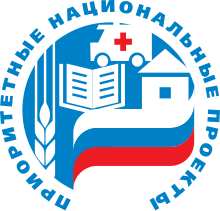National projects (Russia)
The National Projects ( Russian Приоритетные национальные проекты ) are a program to promote education, health, agriculture and housing in Russia .
In January 2006, then President Vladimir Putin set the Russian government the goal of "developing Russia into one of the most livable countries in the world by 2020."
history
After electrification, industrialization and the development of space in the 20th century, Russia tackled four new national projects which serve to modernize central areas of the state and society. These future-oriented new national projects serve to promote education, health, agriculture and housing.
The budget of the national projects initially included projects in the order of magnitude of around 5 billion euros per year. From 2011 onwards, more than 12 billion euros (35.6 billion euros for the next three years) will be spent annually on the implementation of priority national projects.
Overall spending on education and agriculture is to be increased by more than 30 percent over the long term, spending on health care by 60 percent and that on housing construction by as much as 300 percent. The additional funds for the national projects come from the stabilization fund , in which part of the income from Russian oil and gas exports was invested.
Until spring 2008, the then First Vice Prime Minister Dmitry Medvedev was responsible for the practical implementation of these national projects, which served him as a stepping stone to the office of President.
health
The National Health Project aims to improve the affordability and quality of medical care for the population. The aim is to reduce mortality and to increase life expectancy from only 65.3 years in 2005.
These goals are to be achieved through salary increases for the medical staff, the renewal of the fleet of the medical emergency services and the expansion of preventive medical examinations for employees.
Since 2006, for example, expectant mothers have been able to choose the clinic in which their child should be born. Vouchers worth 2,000 rubles (60 euros) for care during pregnancy and 5,000 rubles (150 euros) for obstetrics are intended to ensure competition among hospitals.
As early as 2007, the first successes of investments of around 2.5 billion euros per year in the health care system alone were registered, among other things due to the 11 percent increase in the birth rate and the 9 percent decrease in mortality.
education
The national education project is primarily intended to align training to actual demand on the labor market and to improve the quality of training. These goals are to be achieved through salary increases for educational staff, the promotion of competition between universities, a reform of university access and the introduction of the two-tier university system as part of the Bologna process.
housing
The National Housing Project aims to promote state housing and stimulate private housing construction. These goals are to be achieved through substantial government funding for mortgage loans and the renovation of obsolete or dilapidated buildings.
From 2005 to 2007 alone, state investments in residential construction increased from 1 billion to 11 billion euros.
Agriculture
The National Project Agriculture aims to increase the quantity and quality of agricultural production, encourage the establishment of small businesses and improve the standard of living of the rural population.
Web links
- Official website (russian)
Individual evidence
- ^ DGAP: 11th Future Workshop of the Petersburg Dialogue . German Society for Foreign Policy. February 14, 2008. Retrieved March 21, 2010.
- ^ RIA Novosti: Russia plans to spend 1.4 trillion rubles on national projects in three years . RIA Novosti. July 29, 2010. Retrieved July 29, 2010.




